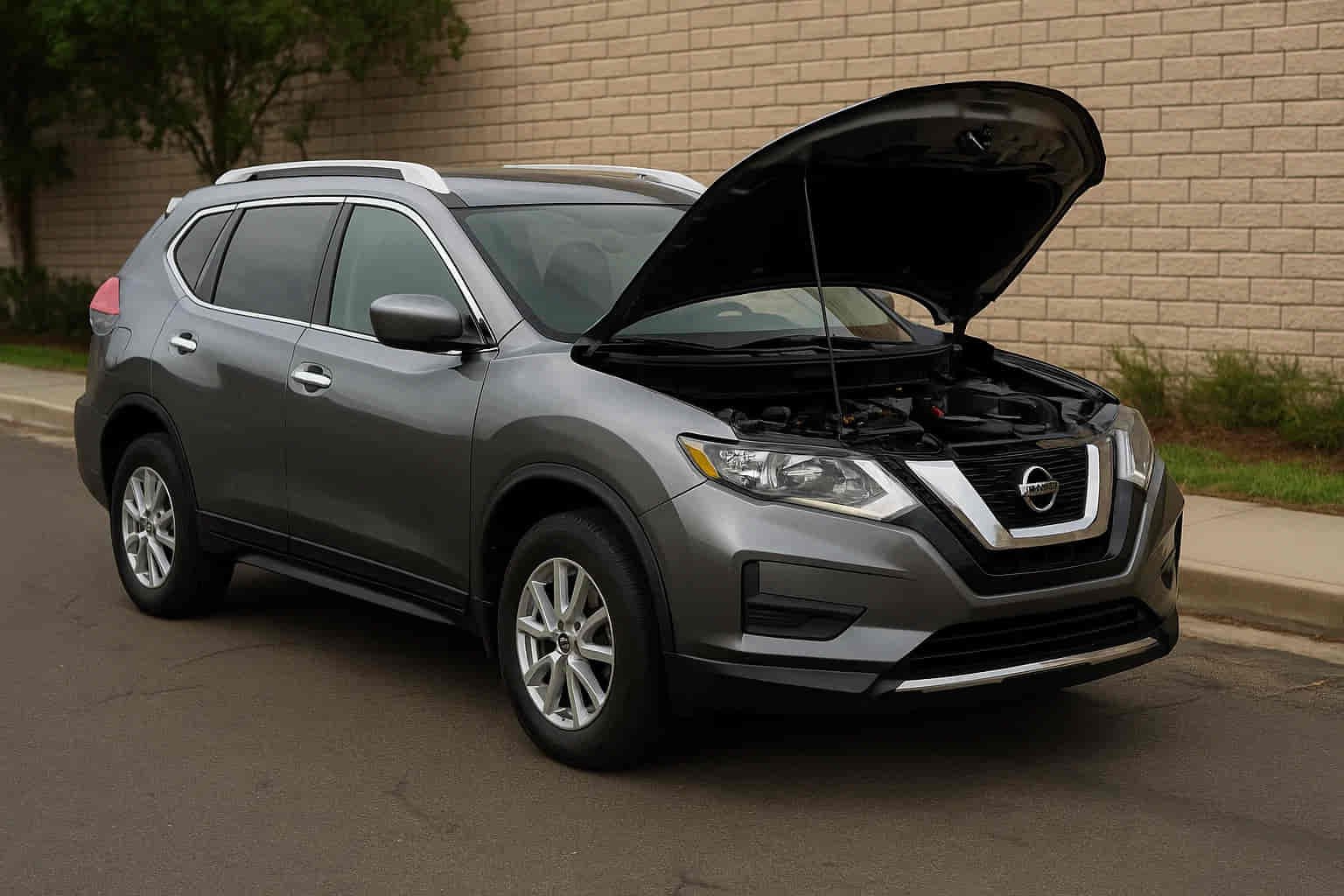In recent years, Nissan Rogue transmission problems have become one of the most discussed topics among crossover owners and automotive forums alike. Drivers describe a familiar pattern—smooth performance during the first few years, followed by unexpected jerks, delayed acceleration, and a haunting whining noise that signals the beginning of CVT trouble. While Nissan’s Continuously Variable Transmission (CVT) was designed to deliver fuel efficiency and seamless shifting, real-world experiences often tell a different story.
According to multiple reliability reports and customer data collected up to 2025, the Rogue’s CVT remains a double-edged sword: efficient yet fragile. Many owners report issues appearing before 100,000 miles, leading to costly repairs or even full transmission replacements. These recurring issues have sparked discussions, recalls, and even class-action lawsuits against the manufacturer. However, not all is doom and gloom. With updated engineering, improved fluid systems, and better awareness of maintenance schedules, many of these problems can now be diagnosed early and fixed before they become catastrophic.
This complete 2025 guide will help you understand why Nissan Rogue transmission problems happen, what causes them, how much repairs actually cost, and—most importantly—what steps you can take to prevent them in the future. Whether you drive a 2015 Rogue or a brand-new 2025 model, knowing how to handle CVT issues could save you thousands of dollars and extend your vehicle’s lifespan.
What Makes Nissan Rogue’s CVT Transmission Different?
The heart of every Nissan Rogue lies in its CVT—Continuously Variable Transmission—a design that set it apart from competitors when it was first introduced. Instead of relying on traditional gears, the Rogue’s CVT uses a system of pulleys and steel belts to create infinite gear ratios. In theory, this allows for smoother acceleration, consistent power delivery, and improved fuel economy. It was Nissan’s promise of a more refined and efficient driving experience, especially for city commuters and family drivers who valued comfort over sportiness.
However, the same innovation that made the CVT appealing also became its biggest challenge. Unlike a conventional automatic transmission, which can tolerate higher mechanical stress, the CVT depends heavily on fluid pressure and precise calibration. When the transmission fluid overheats or the belt tension drops, the system begins to slip or shudder—a problem many Rogue owners start noticing around mid-mileage. Compounding this, early CVT units manufactured by Jatco, Nissan’s transmission supplier, were often criticized for inadequate cooling systems that couldn’t handle prolonged heat cycles.
Nissan has made several improvements over the years, refining its software and enhancing the transmission’s internal cooling components. Yet, despite these updates, the phrase “Nissan Rogue transmission problems” continues to trend in 2025 search results, proving that drivers still seek clarity and reliability. Understanding how the CVT works—and where it tends to fail—is the first step toward smarter ownership and more informed maintenance decisions.
Common Nissan Rogue Transmission Problems (2025 Data)
By 2025, patterns in Nissan Rogue transmission problems have become more predictable thanks to a decade of owner reports, recall data, and mechanical analyses. Most issues begin subtly—drivers notice a faint vibration during acceleration or a delay when pressing the gas pedal. Over time, these signs evolve into more severe symptoms such as gear slipping, loud whining noises, or a sudden loss of power on the highway. What appears as a minor hesitation in the early stages often leads to complete CVT failure if ignored.
One of the most frequently documented issues involves overheating transmission fluid. When the CVT runs hot, the steel belt inside begins to lose friction, causing the car to jerk or surge unexpectedly. In long commutes or under heavy loads, this heat stress accelerates internal wear. Another recurring problem stems from defective valve bodies and solenoids, components that regulate hydraulic pressure. When they malfunction, the transmission struggles to maintain consistent gear ratios, leading to the infamous “shudder” many Rogue drivers describe.
Recent data from RepairPal and CarComplaints indicates that CVT-related failures account for more than 35% of major repairs among Rogues produced between 2014 and 2020. Although newer models—especially from 2022 onward—show improvement, isolated cases continue to surface. The problem isn’t purely mechanical; software glitches and sensor misreadings have also been linked to poor shift timing and unpredictable performance.
Ultimately, these recurring transmission issues paint a clear picture: while the Rogue remains one of Nissan’s best-selling SUVs, its CVT still represents the brand’s most polarizing engineering decision. Understanding the warning signs early is critical—not only to prevent costly breakdowns but also to preserve long-term reliability and resale value.
What Causes Nissan Rogue Transmission Problems?

The root causes behind Nissan Rogue transmission problems lie in a combination of engineering limitations, environmental stress, and maintenance habits. While the CVT was introduced as a cutting-edge alternative to conventional automatic transmissions, its sensitivity to heat and pressure quickly became apparent in real-world driving conditions. Early-generation CVTs—particularly those installed between 2014 and 2020—were plagued by inadequate cooling systems. The transmission fluid, designed to lubricate and regulate temperature, often reached excessive heat levels during long drives or stop-and-go traffic, leading to premature wear on the belt and pulleys.
Another critical factor comes from the transmission’s internal software calibration. Nissan’s Jatco-supplied CVTs rely heavily on electronic sensors to interpret driving behavior and adjust gear ratios on the fly. When these sensors misread inputs or lag in response, they cause the transmission to hesitate or slip during acceleration. Over time, repeated miscalibrations can strain the system, resulting in reduced efficiency and erratic performance.
Manufacturing consistency also plays a role. Reports from independent repair specialists show that minor variations in valve body production and clutch pack quality have caused uneven pressure distribution inside the transmission. Combined with infrequent fluid changes—a common oversight among drivers who assume CVTs require less maintenance—the transmission begins to degrade far earlier than expected.
Legal actions and recall campaigns in the U.S. further underline the systemic nature of the issue. Class-action lawsuits filed against Nissan highlight claims of design defects and premature CVT failures, pushing the automaker to extend warranties and issue software updates in several markets. Yet even as newer models show mechanical improvements, the legacy of these problems continues to affect consumer confidence. Understanding these underlying causes isn’t just about diagnosing a fault—it’s about recognizing the complex interaction between technology, usage, and the long-term reliability of Nissan’s most popular SUV.
How to Fix Nissan Rogue Transmission Problems
Fixing Nissan Rogue transmission problems begins with understanding that not every symptom requires a complete transmission replacement. The CVT’s design is intricate, and sometimes what feels like a catastrophic failure is the result of fluid degradation, software miscalibration, or a clogged valve body. The first and most crucial step is diagnosis—something that a skilled technician with CVT experience can perform using pressure tests and software scans. Identifying whether the issue is mechanical or electronic determines whether you’re facing a minor adjustment or a multi-thousand-dollar repair.
For mild performance issues such as hesitation or mild shuddering, a simple CVT fluid exchange can dramatically improve drivability. Nissan recommends using NS-3 fluid, which not only lubricates but also helps stabilize internal temperatures. In many 2015–2020 Rogues, outdated transmission control software contributed to erratic shifting; updating this software through a certified Nissan dealer often restores smoother performance. When the damage is deeper—such as belt slippage or internal bearing wear—mechanics may recommend replacing the valve body or rebuilding the transmission. These repairs typically cost between $1,500 and $3,000, depending on parts and labor.
However, if the CVT is severely damaged, full replacement is often unavoidable. A brand-new CVT unit for a Nissan Rogue can exceed $5,000, though refurbished options and extended warranties can significantly reduce that burden. Nissan has introduced goodwill programs and CVT warranty extensions for certain model years, covering partial costs if the failure occurs under specific mileage thresholds. Drivers are advised to document every service visit and complaint—doing so strengthens claims for warranty coverage or reimbursement.
In the end, fixing transmission problems isn’t just about swapping parts. It’s about proactive maintenance, accurate diagnostics, and partnering with a mechanic who understands the quirks of Nissan’s CVT system. When handled correctly, even a troubled Rogue can regain its reliability and continue to serve its driver for many years beyond the expected lifespan of its transmission.
Nissan Rogue Transmission Recall & Warranty Info (2025 Update)
By 2025, Nissan’s ongoing efforts to address Nissan Rogue transmission problems have resulted in a complex network of recalls, extended warranties, and settlement programs designed to restore consumer confidence. While not every model year has been part of a formal recall, many Rogue owners have benefited from service bulletins and warranty extensions that quietly acknowledged the CVT’s recurring weaknesses. These measures were primarily aimed at earlier model years—especially between 2014 and 2020—when complaints peaked across the U.S. and Canada.
According to the National Highway Traffic Safety Administration (NHTSA) database, certain Rogue and Rogue Sport units were subject to recall campaigns for issues linked to transmission overheating and control module failures. These recalls often involved software reprogramming and fluid cooler upgrades rather than full replacements. Nissan’s internal Customer Service Bulletins (TSBs) also recommended specific diagnostics for delayed acceleration and whining noises, encouraging dealers to verify CVT fluid quality before authorizing major repairs.
In addition to recalls, Nissan implemented an extended warranty policy for select CVT-equipped vehicles, expanding coverage to 10 years or 120,000 miles in some regions. This move came after multiple class-action lawsuits accused the automaker of concealing known CVT defects. Settlement agreements, finalized between 2020 and 2023, provided partial reimbursements for out-of-pocket transmission repairs and free software updates for affected owners.
For 2025 models, Nissan claims to have fully resolved the underlying mechanical and thermal issues. The redesigned CVT now includes improved cooling channels, upgraded steel belt materials, and smarter transmission control logic. Still, owners are urged to check their vehicle identification number (VIN) on Nissan’s official recall website or contact a local dealer to confirm eligibility for any outstanding programs. Staying proactive about recalls and warranty status remains one of the most effective ways to minimize repair costs and maintain long-term peace of mind.
How to Prevent Future CVT Problems
Preventing Nissan Rogue transmission problems begins long before the first sign of failure. The CVT, while efficient, is a delicate system that demands consistent care and attention to detail. Unlike traditional automatic transmissions, the Rogue’s CVT operates under constant pressure and temperature fluctuations, which means small lapses in maintenance can escalate into major mechanical failures. Regular servicing is not a luxury—it’s a necessity that determines whether your transmission lasts 60,000 miles or doubles that lifespan.
The foundation of CVT health is its fluid. Nissan’s NS-3 transmission fluid is engineered to manage heat and friction within precise tolerances. Allowing it to degrade or run low can quickly lead to overheating and belt slippage, the two most common precursors to CVT failure. Replacing the fluid every 40,000 to 60,000 miles—or sooner under heavy driving conditions—helps sustain the internal hydraulic balance that keeps the transmission performing smoothly. Pairing this with proper cooling system checks prevents the buildup of excessive thermal stress that shortens the CVT’s lifespan.
Driving habits also play a crucial role in preventing future issues. Continuous stop-and-go traffic, towing heavy loads, or accelerating aggressively puts additional strain on the transmission’s internal components. Gentle throttle application and avoiding prolonged idling can significantly reduce wear. It’s also wise to periodically update the transmission’s control software at a certified Nissan dealer, ensuring that calibration matches the latest factory standards.
Ultimately, maintaining a Nissan Rogue is about adopting a proactive mindset. Those who treat their CVT as a high-precision component rather than a sealed, maintenance-free system enjoy fewer breakdowns and better fuel economy. When combined with awareness of recalls, warranty programs, and routine inspections, these habits form the strongest defense against the persistent challenge of Nissan Rogue transmission problems.
Conclusion
Nissan Rogue transmission problems have long been a source of frustration and debate among owners, mechanics, and automotive reviewers. What began as an ambitious engineering choice—the CVT promising smoothness and fuel efficiency—turned into one of Nissan’s most persistent challenges. Yet, the story has evolved. With years of feedback, design refinements, and warranty programs, Nissan has taken visible steps toward rebuilding driver trust. The 2025 Rogue, equipped with a redesigned CVT system, stands as proof that the company has learned from its earlier missteps.
For current Rogue owners, knowledge remains the best defense. Recognizing early warning signs, maintaining proper CVT fluid intervals, and keeping up with recall updates can make the difference between a manageable service visit and a costly repair. Those planning to buy a used Rogue should check its maintenance history and verify whether any factory updates or warranty extensions apply.
At its core, this isn’t just about fixing a mechanical issue—it’s about understanding the relationship between technology and responsibility. The Nissan Rogue continues to be a capable, family-friendly crossover when cared for correctly. Whether you’ve faced transmission issues or are simply looking to prevent them, proactive maintenance and informed ownership are the keys to keeping your Rogue running smoothly for years to come.
Have you experienced any transmission issues with your Nissan Rogue? Share your story below—your insight could help another driver avoid the same problem.

